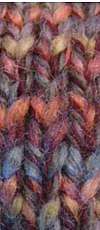Increase (knitting)
In knitting, an increase is the creation of one or more new stitches, which may be done by various methods that create distinctive effects in the fabric.
Methods of Single Increasing (knitting)
- Yarn-over increase or "eyelet increase"—The simplest increase is to do a yarn-over between two existing stitches. On subsequent rows, the yarn-over will be knitted, making a new stitch. This disadvantage of this method is that a small hole (eyelet) is produced at the yarn-over. This can be improved by twisting the yarn-over stitch - similar to a "make one" (below).
- Raised Increase -- Lift the strand connecting two knitted stitches in the row below onto the left needle (effectively producing a yarn-over) and knit it, either normally or twisted. This method (especially if twisted) leaves almost no hole, since forming the yarn-over stitch from the (presumably tight) connecting strand draws the two neighboring stitches together.
- Bar increase -- Knit the stitch normally but without transferring the knitted stitch to the right needle; the same stitch is then knitted through the back loop. (Knitting through the front loop again is not feasible, since it would undo the first stitch.) This increase makes a bar or a nub on the fabric.
- Moss increase -- Knit the stitch normally but without transferring the knitted stitch to the right needle; the same stitch is then purled. This increase makes a bar or nub on the fabric.
- Lifted Increase -- For a right-side increase, knit into the right leg of the stitch of the row below the next stitch to be knit, then knit the next stitch. For a left-side increase, knit one stitch, then knit into the left leg of the stitch of the row below it. This kind of increase can be visually subtle.
- "Make One" (M1) -- Place a half-hitch loop on the needle between two stitches, either before or after, and twisted either left or right, depending on desired effect.
- Column of Increases -- A second strand of yarn or roving is passed up the piece. The second strand is used to make an extra stitch in each row by knitting a doubled stitch up from the lower row. The resulting piece has one more stitch in each row and each row is in the shape of an inverted V. The column of increases is used to make square sweater yokes.
Finally, a large number of increases in a row is best done by casting on; examples include buttonholes, etc.
Role in fabric shaping
The typical use for increases and decreases is to taper a flat piece of knitted fabric, e.g., in widening the sleeve of a sweater from the wrist to the biceps. However, increases and decreases can also be used to produce curvature, i.e., to make the knitted fabric cup (positive curvature) or gather (negative curvature); in woven fabrics, this curvature is produced with darts, flares and gussets. A great advantage of knitted fabrics is that they can be shaped nearly invisibly without seams or cutting (as woven fabrics must) with increases, decreases, and/or short rows.
See also
References
- (2002) Vogue Knitting: The Ultimate Knitting Book, updated ed., Sixth and Spring Books. ISBN 1-931543-16-X
- (1979) Reader's Digest Complete Guide to Needlework, Reader's Digest Association. ISBN 0-89577-059-8
- June Hemmons Hiatt (2012) The Principles of Knitting, Simon and Schuster, pp. 94–97 and 206-216. ISBN 978-1-4165-3517-1
